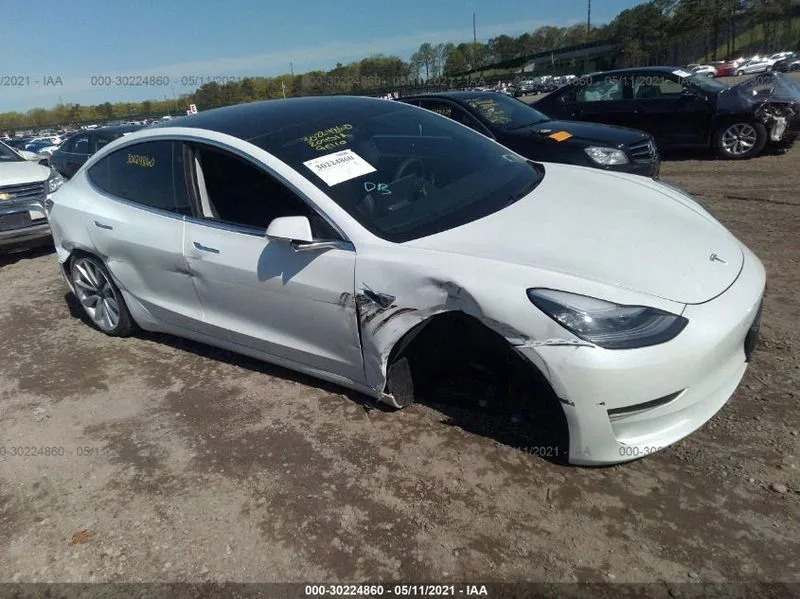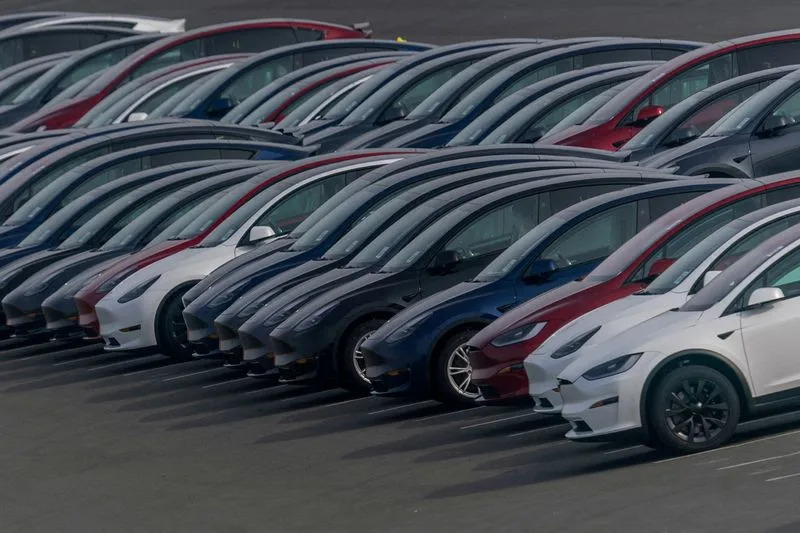Vivian Chow
KTLA
Thu, December 28, 2023
Thu, December 28, 2023
Video captured the terrifying moment beachgoers were slammed into by a massive rogue wave in Ventura on Thursday.
The incident happened as locals were being warned about a massive swell pounding the Southern California coastline this week.
The rogue wave submerged bystanders at Pierpont Beach on Seaward Avenue around 11 a.m. That area has been hit the hardest with what the National Weather Service called “tremendous wave energy.”
A witness, Colin Hoag, captured cell phone video of the explosive wave. As the waters suddenly flooded an observation zone, both people and vehicles were instantly swept away.
Beachgoers were seen frantically running for their lives. The raging waters destroyed the windows of nearby beachfront buildings and hotels on its destructive path.
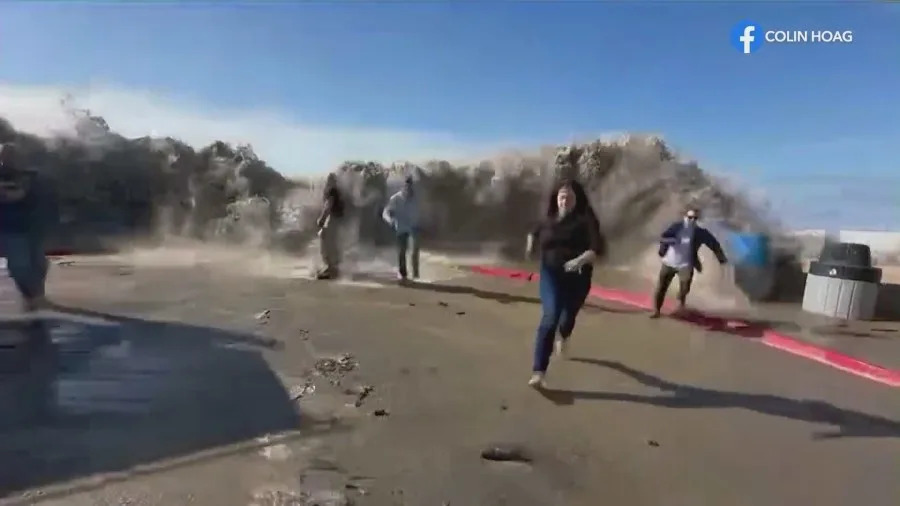
Video captured the moment beachgoers were slammed into by a massive rogue wave in Ventura County on Dec. 28, 2023, sending nine people to the hospital. (Colin Hoag)

Video captured the moment beachgoers were slammed into by a massive rogue wave in Ventura County on Dec. 28, 2023, sending nine people to the hospital. (Colin Hoag)
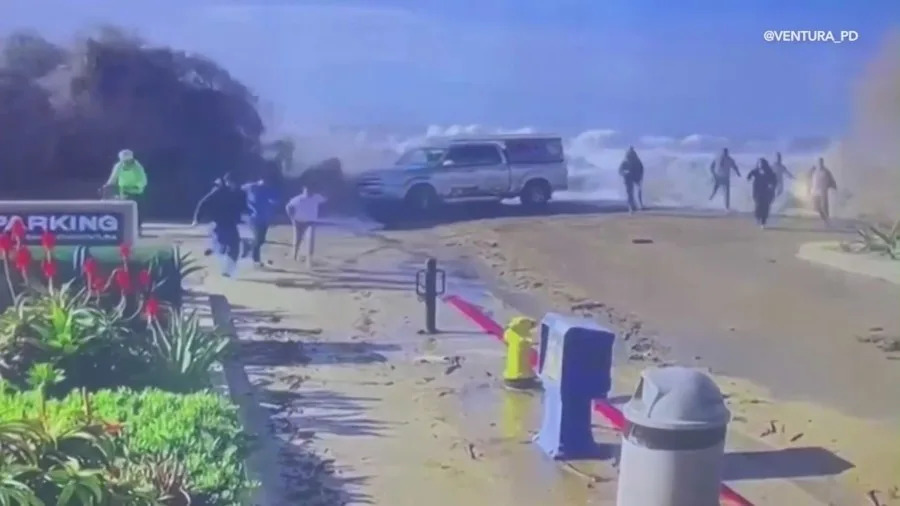
Video captured the moment beachgoers were slammed into by a massive rogue wave in Ventura County on Dec. 28, 2023, sending nine people to the hospital. (Ventura Police Department)

Video captured the moment beachgoers were slammed into by a massive rogue wave in Ventura County on Dec. 28, 2023, sending nine people to the hospital. (Ventura Police Department)

Video captured the moment beachgoers were slammed into by a massive rogue wave in Ventura County on Dec. 28, 2023, sending nine people to the hospital. (Colin Hoag)
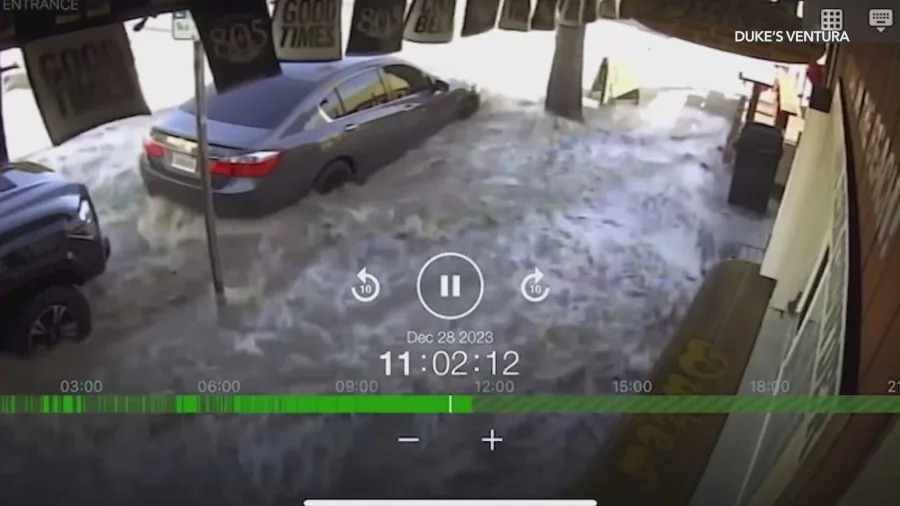
Video captured the moment beachgoers were slammed into by a massive rogue wave in Ventura County on Dec. 28, 2023, sending nine people to the hospital. (Duke’s Ventura)
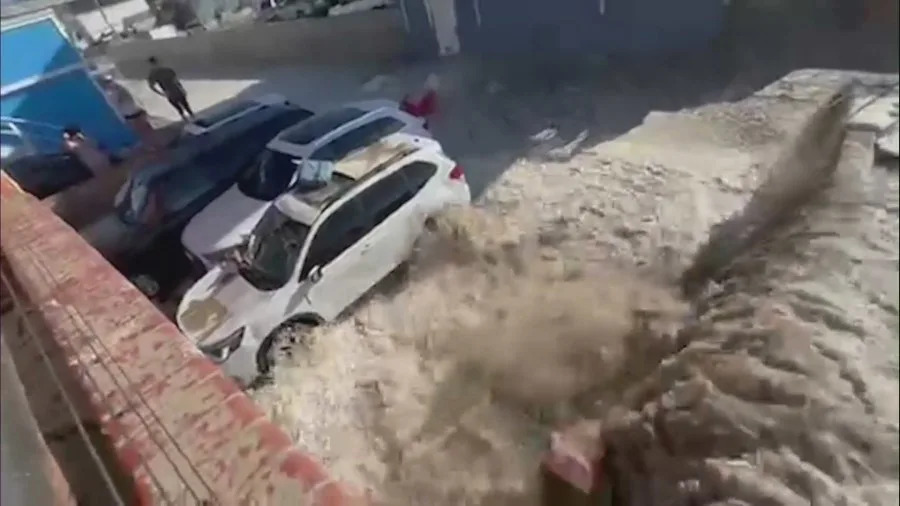
Video captured the moment beachgoers were slammed into by a massive rogue wave in Ventura County on Dec. 28, 2023, sending nine people to the hospital.
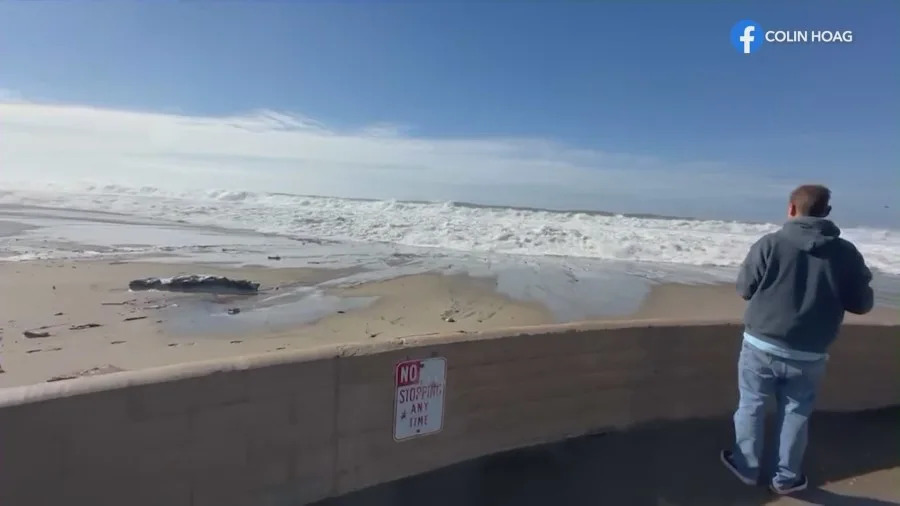
Video captured the moments of calm before beachgoers were slammed into by a massive rogue wave in Ventura County on Dec. 28, 2023, sending nine people to the hospital. (Colin Hoag)
Nine people were rushed to the hospital by paramedics. Witnesses said several victims suffered broken bones. Two of the victims remain in critical condition on Thursday night.
“It was horrific,” Hoag recalled. ‘There was a lot of screaming, a lot of yelling. I didn’t know how far [the wave] would go. I thought, ‘This is a tsunami, is what it looks like to me.’”
“I think a lot of lessons were learned today when you look at that video,” said Andy VanSciver from the Ventura County Fire Department. “The importance of heeding the warnings, about giving the ocean some respect.”
Warnings of dangerous high surf and flooding are highest for Ventura County along with Hermosa, Manhattan and Palos Verdes beaches, according to the NWS.
Waves of 10 to 15 feet with sets to 20 feet are expected along the Ventura County coast. A high surf warning and coastal flood warning are in effect from 4 a.m. Thursday to 10 p.m. Saturday.
Despite the warnings, visitors kept hanging out at the beach and entering the ocean, authorities said. When emergency personnel weren’t dealing with people on land, they were rescuing surfers and swimmers who had unsuccessfully tried to challenge the dangerous waves.
“We ask people to stay out [of the water] because it puts rescuers in harm’s way as well,” explained Capt. Brian McGrath with Ventura County Fire. “The sea, it’s unforgiving and we know what to expect.”
Throughout the week, meteorologists warned communities along the central and Southern California coast about the impending dangers — monster waves, life-threatening rip currents, damaging coastal flooding and significant beach erosion.
The high surf will stick around through late Saturday night as locals begin recovering and rebuilding the damaged beachfront businesses in Ventura.
County firefighters will be patrolling the beaches often over the next few days. Crews will be building a 6 to 8-foot high sand berm stretching a mile long to help protect the beach.
All Ventura County beaches and the Ventura Pier will remain closed at this time.
Public safety officials are asking the public to stay out of the water and maintain a safe distance from the shoreline, especially after the destruction caused by the rogue wave.
Huge waves damage homes, cause injuries along California coast
Karen Garcia, Ashley Ahn, Christian Martinez
Karen Garcia, Ashley Ahn, Christian Martinez
Los Angeles Times
Thu, December 28, 2023

Men watch from a balcony in Faria Beach as huge waves crash on the shore in Ventura. (Brian van der Brug/Los Angeles Times)
California’s first huge swells of the winter are wreaking havoc on the state’s coastline as an incoming atmospheric river storm forces evacuations amid flooding of beach and coastal roads.
The extreme weather has been blamed for several injuries, ocean rescues, flooding and evacuation orders at coastal cities through the state. Ventura County was particularly hard hit.
In Ventura County, waves of up to 12 feet have already been reported, and the Central Coast has seen 18- to 20-foot swells, said Mike Wofford with the National Weather Service's Oxnard office.
High surf advisories remained in effect throughout Ventura County on Thursday, with local officials imploring the community to stay away from the water as multiple rescues were conducted in the morning.
Eight people sustained minor to moderate injuries and were taken to the hospital after large waves caused flooding near South Seaward Avenue at approximately 10:50 a.m. Thursday, Ventura County Fire Department Captain Brian McGrath said.
Of the injured, some were located in the Inn On The Beach, a boutique hotel located on the beach now closed due to flooding, he said.
The Ventura County Fire Department also rescued at least 15 people out of the ocean Thursday morning during high tide, McGrath added. None sustained injuries, he said.
At the Inn on the Beach, located on Seaward Avenue, things were messy.
The floor of the lobby was covered in mud and sand. The carpet squished with water as Jay Williams, the manager, walked across it.
At around 10:45 a.m., a rogue wave had slammed into the hotel, flooding rooms with nearly 2 feet of water.
The force of the wave smashed glass that has been on the patios of rooms facing the ocean.
The wall of water tossed furniture to and fro. Desks and beds and dressers stood at odd angles inside rooms, covered in mud.
Luckily no guests were injured, although some were stuck in their rooms for a short time.
Around 45 guests were evacuated from the hotel, which will have to close for an unknown amount of time.
“The beach had a lot of looky loos out here,” Williams said. Before the wave hit the hotel, the scene outside was joyful. “There was a couple smaller bigger waves that came in, washed a railroad tie out in the street here. Kids were giggling.”
But once waves began reaching the street, the situation changed. One wave that washed onto Seaward dragged a man a short distance down the street. And people became trapped near their cars.
All beaches in Ventura County are closed until further notice, McGrath said.
The closure extended to Faria Beach Campground, which sustained damages from the waves.
“Riprap rocks were thrown into the middle of the roadway, gravel and mud are everywhere, picnic tables and fire rings were tossed to the other side of the park and extensive flooding” occurred, according to county officials.
Evacuation orders were issued for parts of Marin County, and residents were ordered to evacuate to Stinson Beach Community Center.
Santa Cruz County issued an evacuation warning Thursday on X, formerly known as Twitter, for coastal areas near Seacliff State Beach because of flooding.
Within the evacuation area, the tourist hot spot known as the Rio del Mar Esplanade is currently flooded with several inches of stormwater. On X, the California Highway Patrol cautions that residents avoid the area and not attempt to drive across or through.

Sand, water and foam inundated Pittsfield Lane after a seawall and sand berm was breached in Ventura. (Brian van der Brug / Los Angeles Times)
According to the National Weather Service’s coastal flood warning for the Bay Area, large breaking waves are causing significant flooding of beach and coastal roads. The waves are depositing large amounts of debris and causing road closures.
In Monterey County, park rangers closed Point Lobos State Natural Reserve on Thursday, saying high surf was washing into trails and rendering the entire park unsafe. The closure sent caravans of tourists heading south on Highway 1 to safer places further down the coast. Bluffs that were normally sparsely populated were bursting with tourists, watching as waves crashed 10 and 20 feet over rocks just off shore.
In the nearby city of Carmel, highway patrol and police cars blocked a section of the shoreline drive from traffic because of waves crashing up the beach and onto the shore. Dozens of people stood on a hilly neighborhood in Carmel Point, trying to capture photos of the giant waves, which were smashing into houses and crashing up beach staircases.
Despite the warnings from authorities, the extreme weather and massive waves have drawn surfers to the water and onlookers to the shores.

Pierpont neighbors help shovel sand on Bath Lane to help water drain after a seawall and sand berm were breached by high surf in Ventura. (Richard Vogel/Associated Press)
Just north of the town Half Moon Bay, on the coast between San Francisco and Silicon Valley, the surf break known as Mavericks hosts some of the largest waves in the U.S. and attracts big-wave surfers from around the world.
More than a dozen surfers were spotted catching the waves at Mavericks Thursday morning, with thousands of spectators gathered at the cliffs to watch, said Tina Lourenco, who works at Old Princeton Landing — a popular restaurant and bar for locals and surfers in Half Moon Bay.
“There’s a ton of people right now. You can’t even park in the area,” she said. “Lots of families are coming down. It’s really exciting.”
She estimates about 10 jet skis were also on the waters to aid the surfers. Old Princeton Landing, just a short walk from the water, has also seen an uptick in customers in the past several days, Lourenco said.
“The vibe here is definitely insane, a lot of energy and excitement, and we’ll definitely get some of the surfers in here at the end of the day,” she said.
Brian Overfelt, Old Princeton Landing owner and former surfer, has lived in Half Moon Bay for nearly 50 years and oversaw the nation’s premier big wave surf event, Titans of Mavericks, as a board member until the contest was canceled in 2017. He’s seen it all, but called Thursday’s conditions at Half Moon Bay "gnarly and dangerous."
“Somebody could die at any moment,” he said. “The waves are so big out there that it’s unruly.”

Pierpont resident Ted Teetsel shovels sand out of neighbor Linda Fisher's garage on Greenock Lane after the area was flooded. (Brian van der Brug/Los Angeles Times)
Waves at Mavericks reached about 50 to 60 feet Thursday afternoon, he said. It’s the kind of waves that big-wave surfers travel the world for, but Overfelt said the rain and south winds make the waves choppier and more dangerous for surfers.
In conditions such as these, everyone in the water, including surfers and those on jet skis, should be fully trained in water rescue, Overfelt said.
“If you’re a photographer on a jet ski and you don’t have rescue equipment, you really should not be out there,” he said. “Anyone out there should be ready and trained to do full rescue, no matter what you’re doing.”
Despite the unruly conditions, the atmosphere at Half Moon Bay and the surfing community this week is one of excitement.
“This is what they live for,” he said. “Kids are calling for boat rides. People are calling to borrow my jet skis. The energy is in the air.”
The National Weather Service office in Monterey Bay encouraged beachgoers to stay out and away from the water.
"These conditions are very dangerous, I would go so far as to say they're deadly on the coast," said NWS meteorologist Alexis Clouser.
Visitors to the shores should keep a "healthy distance" from the water and stay off rocks, piers and jetties because if a wave washes up it has the potential to sweep a person out into the ocean, she said.
"If you do happen to see [a person] in the water or let's say a dog, don't go into the water after them. Call 9-1-1 and wait for a professional," Clouser said.

The streets are flooded in Capitola on Dec. 28 as powerful surf is rolling onto beaches on the West Coast (Nic Coury / AP)
The high surf in Northern California isn't unusual for this time of year, meteorologists say.
In January, a series of atmospheric river storms caused high surf and flooding that left beaches in shambles and destroyed sections of piers in the seaside town of Capitola and in Seacliff.
During the current storm, the San Francisco Bay Area coast could see waves up to 40 feet in some locations. The National Weather Service issued a warning for residents to stay away from rocks, jetties, piers and other waterside infrastructure.
In Southern California, the waves aren't expected to be as big, but high surf is expected through Saturday, meteorologists say.
A high surf advisory went into affect at 4 a.m. Thursday for Point Conception in Santa Barbara County and Hermosa Beach, Manhattan Beach and Palos Verdes Peninsula beaches in Los Angeles County, all of which can expect sets of 15- to 20-foot waves and dangerous rip currents.
Read more: Another storm is coming to Southern California. Could it rain on the Rose Parade?
"We're expecting the highest waves today to be arriving either late morning or early afternoon and then, maybe some drops in height tomorrow, but still well above normal," Wofford said.
The waves will pick back up Saturday when another surge of higher swells arrives.

A surfer rides a wave at Surfer's Point on Thursday in Ventura. (Brian van der Brug/Los Angeles Times)
There have been really strong storms over the Pacific Ocean that "we don't necessarily see because they move up to the north or go in some other direction," Wofford said.
While the storms are moving through, strong winds can form big waves, which "propagate out along, and the waves just come barreling right in," he said.
The ingredients for high walls of water include strong wind, time and distance.
Clouser said strong winds that blow for a long time over the ocean surface generates a swell. When the winds continue to strengthen, the swell gets larger as it approaches the coastline and into the beach.
"If you have, for example, a really steep sloped beach, you're going to have higher waves heights that break [going] up the coast," she said.
A recent study found that the extreme waves along the California coast are due to climate change, and an increase in ocean temperatures, which is resulting in "climate-induced heightened wave activity."
Along with the high surf advisory for the Los Angeles-area beaches, the National Weather Service issued a coastal flood advisory through 10 p.m. Saturday.

Surfers wait for a wave in high surf at Manhattan Beach, Calif. on Thursday, Dec. 28, 2023. (Richard Vogel/Associated Press)
Read more: Did you just get a flood warning? Here’s how to check your flood risk
Although no structural or road damage is expected, there is an increased risk for drowning, the agency warned. Rip currents can pull swimmers and surfers out to sea, and large breaking waves can cause injuries, wash people off beaches or rocks and capsize small boats.
"Never turn your back to the ocean," said the National Weather Service on X.
Staff writer Jessica Garrison contributed to this story
This story originally appeared in Los Angeles Times.
Thu, December 28, 2023

Men watch from a balcony in Faria Beach as huge waves crash on the shore in Ventura. (Brian van der Brug/Los Angeles Times)
California’s first huge swells of the winter are wreaking havoc on the state’s coastline as an incoming atmospheric river storm forces evacuations amid flooding of beach and coastal roads.
The extreme weather has been blamed for several injuries, ocean rescues, flooding and evacuation orders at coastal cities through the state. Ventura County was particularly hard hit.
In Ventura County, waves of up to 12 feet have already been reported, and the Central Coast has seen 18- to 20-foot swells, said Mike Wofford with the National Weather Service's Oxnard office.
High surf advisories remained in effect throughout Ventura County on Thursday, with local officials imploring the community to stay away from the water as multiple rescues were conducted in the morning.
Eight people sustained minor to moderate injuries and were taken to the hospital after large waves caused flooding near South Seaward Avenue at approximately 10:50 a.m. Thursday, Ventura County Fire Department Captain Brian McGrath said.
Of the injured, some were located in the Inn On The Beach, a boutique hotel located on the beach now closed due to flooding, he said.
The Ventura County Fire Department also rescued at least 15 people out of the ocean Thursday morning during high tide, McGrath added. None sustained injuries, he said.
At the Inn on the Beach, located on Seaward Avenue, things were messy.
The floor of the lobby was covered in mud and sand. The carpet squished with water as Jay Williams, the manager, walked across it.
At around 10:45 a.m., a rogue wave had slammed into the hotel, flooding rooms with nearly 2 feet of water.
The force of the wave smashed glass that has been on the patios of rooms facing the ocean.
The wall of water tossed furniture to and fro. Desks and beds and dressers stood at odd angles inside rooms, covered in mud.
Luckily no guests were injured, although some were stuck in their rooms for a short time.
Around 45 guests were evacuated from the hotel, which will have to close for an unknown amount of time.
“The beach had a lot of looky loos out here,” Williams said. Before the wave hit the hotel, the scene outside was joyful. “There was a couple smaller bigger waves that came in, washed a railroad tie out in the street here. Kids were giggling.”
But once waves began reaching the street, the situation changed. One wave that washed onto Seaward dragged a man a short distance down the street. And people became trapped near their cars.
All beaches in Ventura County are closed until further notice, McGrath said.
The closure extended to Faria Beach Campground, which sustained damages from the waves.
“Riprap rocks were thrown into the middle of the roadway, gravel and mud are everywhere, picnic tables and fire rings were tossed to the other side of the park and extensive flooding” occurred, according to county officials.
Evacuation orders were issued for parts of Marin County, and residents were ordered to evacuate to Stinson Beach Community Center.
Santa Cruz County issued an evacuation warning Thursday on X, formerly known as Twitter, for coastal areas near Seacliff State Beach because of flooding.
Within the evacuation area, the tourist hot spot known as the Rio del Mar Esplanade is currently flooded with several inches of stormwater. On X, the California Highway Patrol cautions that residents avoid the area and not attempt to drive across or through.

Sand, water and foam inundated Pittsfield Lane after a seawall and sand berm was breached in Ventura. (Brian van der Brug / Los Angeles Times)
According to the National Weather Service’s coastal flood warning for the Bay Area, large breaking waves are causing significant flooding of beach and coastal roads. The waves are depositing large amounts of debris and causing road closures.
In Monterey County, park rangers closed Point Lobos State Natural Reserve on Thursday, saying high surf was washing into trails and rendering the entire park unsafe. The closure sent caravans of tourists heading south on Highway 1 to safer places further down the coast. Bluffs that were normally sparsely populated were bursting with tourists, watching as waves crashed 10 and 20 feet over rocks just off shore.
In the nearby city of Carmel, highway patrol and police cars blocked a section of the shoreline drive from traffic because of waves crashing up the beach and onto the shore. Dozens of people stood on a hilly neighborhood in Carmel Point, trying to capture photos of the giant waves, which were smashing into houses and crashing up beach staircases.
Despite the warnings from authorities, the extreme weather and massive waves have drawn surfers to the water and onlookers to the shores.

Pierpont neighbors help shovel sand on Bath Lane to help water drain after a seawall and sand berm were breached by high surf in Ventura. (Richard Vogel/Associated Press)
Just north of the town Half Moon Bay, on the coast between San Francisco and Silicon Valley, the surf break known as Mavericks hosts some of the largest waves in the U.S. and attracts big-wave surfers from around the world.
More than a dozen surfers were spotted catching the waves at Mavericks Thursday morning, with thousands of spectators gathered at the cliffs to watch, said Tina Lourenco, who works at Old Princeton Landing — a popular restaurant and bar for locals and surfers in Half Moon Bay.
“There’s a ton of people right now. You can’t even park in the area,” she said. “Lots of families are coming down. It’s really exciting.”
She estimates about 10 jet skis were also on the waters to aid the surfers. Old Princeton Landing, just a short walk from the water, has also seen an uptick in customers in the past several days, Lourenco said.
“The vibe here is definitely insane, a lot of energy and excitement, and we’ll definitely get some of the surfers in here at the end of the day,” she said.
Brian Overfelt, Old Princeton Landing owner and former surfer, has lived in Half Moon Bay for nearly 50 years and oversaw the nation’s premier big wave surf event, Titans of Mavericks, as a board member until the contest was canceled in 2017. He’s seen it all, but called Thursday’s conditions at Half Moon Bay "gnarly and dangerous."
“Somebody could die at any moment,” he said. “The waves are so big out there that it’s unruly.”

Pierpont resident Ted Teetsel shovels sand out of neighbor Linda Fisher's garage on Greenock Lane after the area was flooded. (Brian van der Brug/Los Angeles Times)
Waves at Mavericks reached about 50 to 60 feet Thursday afternoon, he said. It’s the kind of waves that big-wave surfers travel the world for, but Overfelt said the rain and south winds make the waves choppier and more dangerous for surfers.
In conditions such as these, everyone in the water, including surfers and those on jet skis, should be fully trained in water rescue, Overfelt said.
“If you’re a photographer on a jet ski and you don’t have rescue equipment, you really should not be out there,” he said. “Anyone out there should be ready and trained to do full rescue, no matter what you’re doing.”
Despite the unruly conditions, the atmosphere at Half Moon Bay and the surfing community this week is one of excitement.
“This is what they live for,” he said. “Kids are calling for boat rides. People are calling to borrow my jet skis. The energy is in the air.”
The National Weather Service office in Monterey Bay encouraged beachgoers to stay out and away from the water.
"These conditions are very dangerous, I would go so far as to say they're deadly on the coast," said NWS meteorologist Alexis Clouser.
Visitors to the shores should keep a "healthy distance" from the water and stay off rocks, piers and jetties because if a wave washes up it has the potential to sweep a person out into the ocean, she said.
"If you do happen to see [a person] in the water or let's say a dog, don't go into the water after them. Call 9-1-1 and wait for a professional," Clouser said.

The streets are flooded in Capitola on Dec. 28 as powerful surf is rolling onto beaches on the West Coast (Nic Coury / AP)
The high surf in Northern California isn't unusual for this time of year, meteorologists say.
In January, a series of atmospheric river storms caused high surf and flooding that left beaches in shambles and destroyed sections of piers in the seaside town of Capitola and in Seacliff.
During the current storm, the San Francisco Bay Area coast could see waves up to 40 feet in some locations. The National Weather Service issued a warning for residents to stay away from rocks, jetties, piers and other waterside infrastructure.
In Southern California, the waves aren't expected to be as big, but high surf is expected through Saturday, meteorologists say.
A high surf advisory went into affect at 4 a.m. Thursday for Point Conception in Santa Barbara County and Hermosa Beach, Manhattan Beach and Palos Verdes Peninsula beaches in Los Angeles County, all of which can expect sets of 15- to 20-foot waves and dangerous rip currents.
Read more: Another storm is coming to Southern California. Could it rain on the Rose Parade?
"We're expecting the highest waves today to be arriving either late morning or early afternoon and then, maybe some drops in height tomorrow, but still well above normal," Wofford said.
The waves will pick back up Saturday when another surge of higher swells arrives.

A surfer rides a wave at Surfer's Point on Thursday in Ventura. (Brian van der Brug/Los Angeles Times)
There have been really strong storms over the Pacific Ocean that "we don't necessarily see because they move up to the north or go in some other direction," Wofford said.
While the storms are moving through, strong winds can form big waves, which "propagate out along, and the waves just come barreling right in," he said.
The ingredients for high walls of water include strong wind, time and distance.
Clouser said strong winds that blow for a long time over the ocean surface generates a swell. When the winds continue to strengthen, the swell gets larger as it approaches the coastline and into the beach.
"If you have, for example, a really steep sloped beach, you're going to have higher waves heights that break [going] up the coast," she said.
A recent study found that the extreme waves along the California coast are due to climate change, and an increase in ocean temperatures, which is resulting in "climate-induced heightened wave activity."
Along with the high surf advisory for the Los Angeles-area beaches, the National Weather Service issued a coastal flood advisory through 10 p.m. Saturday.

Surfers wait for a wave in high surf at Manhattan Beach, Calif. on Thursday, Dec. 28, 2023. (Richard Vogel/Associated Press)
Read more: Did you just get a flood warning? Here’s how to check your flood risk
Although no structural or road damage is expected, there is an increased risk for drowning, the agency warned. Rip currents can pull swimmers and surfers out to sea, and large breaking waves can cause injuries, wash people off beaches or rocks and capsize small boats.
"Never turn your back to the ocean," said the National Weather Service on X.
Staff writer Jessica Garrison contributed to this story
This story originally appeared in Los Angeles Times.















